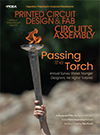News
News
China RoHS: Oxymoronic – and Real
By the time you read this, enactment of China’s version of the RoHS Directive will be less than 60 days away. On March 1, the self-styled World’s Workshop will enact a far-reaching set of requirements on the use of several common hazardous substances. And while companies elsewhere may be able to leverage their EU RoHS plans to accommodate the new rules in China, like most things Mandarin, it’s not a one-to-one translation.
In fact, besides names and substances covered, the differences are greater than the similarities. Unlike the EU RoHS Directive, China’s hazardous substances restriction is not a legislative requirement. The EU version affords makers of high-reliability products some timetable relief, while in China the March deadline immediately affects the automotive, telecom, radar and medical sectors. Curiously, while its scope is broader (an AeA translation runs 35 pages), various toys and home appliances are not covered (although some components of these products are).
China RoHS is a declaration process: Companies must declare what’s in their products and packaging. In the EU, companies stuffed the retail channels with noncompliant product ahead of the July 1, 2006, effective date. In China, importers best beware: Each step – from dock to retail shelf – must be compliant. Enforcement is based on the manufacturing date, which, beginning March 1, must be put on the product.
As described by consulting group Design Chain Associates (designchainassociates.com), the rule will take three phases. In Phase 1, effective March 1, a producer will declare the presence of any hazardous materials above the limits set forth in China RoHS. Phase 2 is the Catalog. Chinese laboratories will test for so-called catalog items. This is a potential bottleneck: Just 18 labs are listed, and China will not accept test results from other labs. The test methods are available only in hard copy, and only in Mandarin. Here’s the other rub: At press time, the catalog was not yet defined, and no timetable set for publication.
Then there’s the much-discussed “homogeneous material” term. In the EU, this means a material “of uniform composition throughout,” in other words, that cannot be mechanically disjointed into different materials. In China, for a component smaller than 4 mm3, the entire component is considered homogeneous. An out-of-scope product containing in-scope materials becomes in-scope itself. Says DCA vice president Ken Stanvick, “For example, washing machines – go figure – aren’t in scope, but if the motor is in scope, then the machine is in scope too.”
Phase 3 covers marking and disclosure (see Global Sourcing, December 2006, page 20). As noted, the manufacturing date must be on the product (if a component goes into a product, labels go on the packaging, not the component). An Environmentally Friendly Use Period (EFUP) must be specified. Yet the EFUP terms are downright bizarre, Stanvick notes: 20 years for cellphones but just seven for CRT TVs.
Stanvick, whose firm has translated the China RoHS document, says disclosure should be provided at the material or subassembly level, not the product level. (Disclosure: On Jan. 18 Circuits Assembly is producing a DCA-led Webinar on China RoHS.) “If you have certificates of compliance or vague assurances from suppliers that their parts are compliant with EU RoHS,” he adds, “get the details now. You will need to supply that to the Chinese, in Mandarin. Questions need to be in Chinese; build in time for translations.”
While the legal implications are impossible to discern, Stanvick says the latest enforcement view is that China has attempted “too big a bite,” and will as such concern itself with the company whose name appears on the label, and not the rest of the chain.
The new rules also forbid the import of electronics products that do not meet national RoHS standards. It is estimated that as much as 72% of the world's e-waste is imported to China for disposal. Such a rule could reverberate through the chain, potentially driving greater use of design for recycling measures and regional repair and refurbishment depots. Rather than ship product to Asian trash heaps, the market may well determine a more profitable approach would be to implement DfR practices. Or perhaps repair depots – already one of the few truly lucrative EMS offerings – will become commonplace, bringing local jobs and higher margins. That would make for a fascinating upside to another otherwise ill-advised rule.
It is ironic, to say the least, that China is pushing so hard on an RoHS plan. While I’ve seen industrial parks there with state-of-the-art waste systems, this same nation is notorious for covering up poisonous chemical spills and for citizens who walk city streets wearing masks to cover their noses and mouths from the polluted air. This should remind North America how important it is to engage the rest of the world, and how our manufacturers need to be involved at every level and every nation in standards development, lest our needs – and common sense – be shrugged off.
Press Releases
- Free Webinar on “Surface Reliability—Overcoming Challenges in SMT PCB Manufacturing and Determining Root Causes for Improved Performance”
- Indium Corporation Technical Manager to Present on Solder Solutions for Cutting-Edge Solutions for AI and Automotive at SEMICON Taiwan
- PVA Welcomes Rod Kasperson as Global Sales Manager
- Seika Machinery Hosts Second Webinar on Process Control: Advanced Testing and Profiling Techniques







